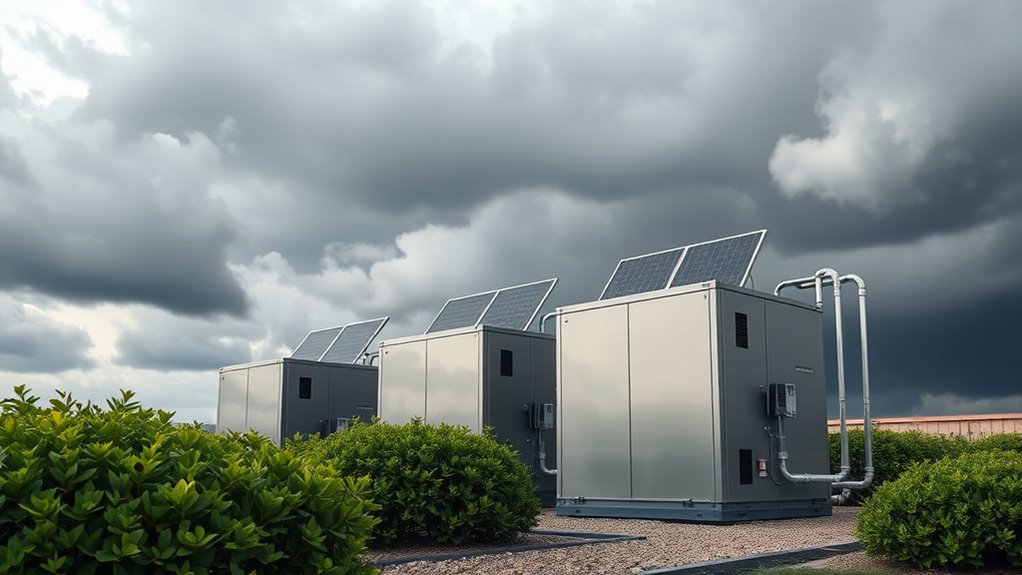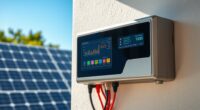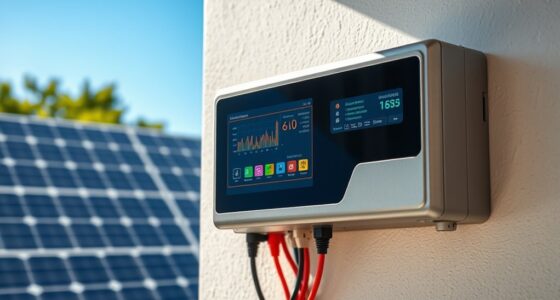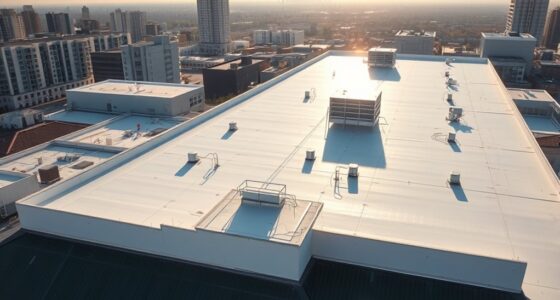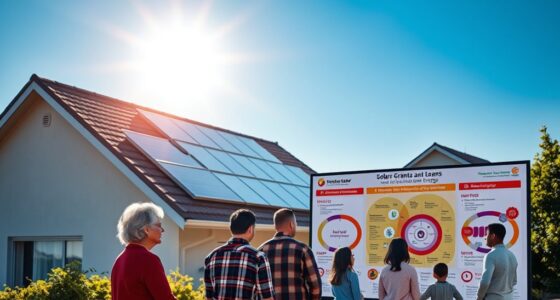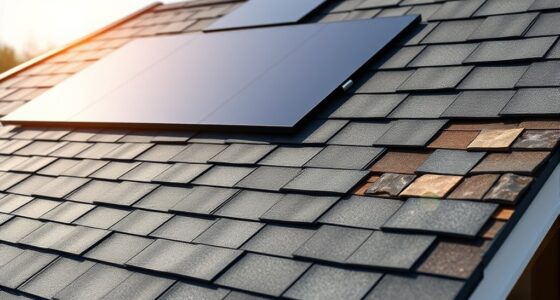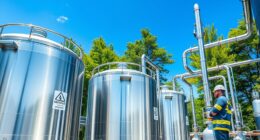In cloudy climates, solar-powered heat pumps face challenges like reduced efficiency due to limited sunlight, dropping energy factors (EF) and seasonal COPs. To overcome this, effective system designs include thermal mass, hybrid setups, and advanced controls that adapt to weather fluctuations. Technologies like bifacial panels and storage buffers help maximize output during overcast days. Exploring case studies and real-world data can show you how these strategies improve performance despite weather obstacles. Discover more about optimizing your system further.
Key Takeaways
- Cloud cover significantly reduces solar input, lowering heat pump efficiency and energy factor (EF) during cloudy days.
- Hybrid systems and advanced controls help maintain performance stability despite weather-induced variability.
- Real-world seasonal COPs typically range from 2.0 to 2.5, with EF dropping sharply on overcast days.
- Bifacial panels and energy storage buffer fluctuating solar energy, improving resilience in cloudy conditions.
- Precise sensor data and predictive weather modeling enable optimized operation and better system performance in variable weather.
Impact of Cloud Cover on Solar Energy Factors
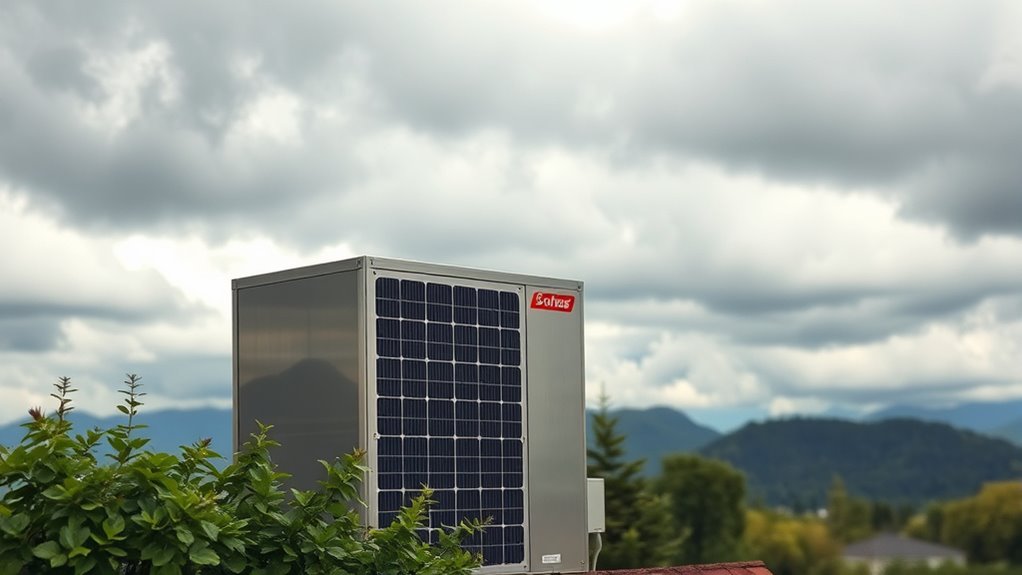
Cloud cover considerably influences the efficiency of solar energy systems by reducing the amount of direct sunlight reaching panels. On heavily overcast days, your solar panels can produce just 10-25% of their peak output because less direct sunlight reaches them. Thin, wispy clouds only slightly decrease performance, allowing about 50% or more efficiency if some sunlight filters through. When thick clouds block most sunlight, production can fall below 10%, sometimes near zero. High-efficiency panels, like SunPower® models, can better capture a broader light spectrum, improving output during cloudy days. Keep in mind that shading from trees combined with cloudiness further affects energy production. Variations in cloud cover cause rapid fluctuations and make real-time output less predictable, especially during shift periods between sun and clouds. Additionally, dog names often reflect personality traits that can be inspired by weather and natural elements, adding a personal touch to your pet’s identity.
Design Strategies for Cloudy Climate Adaptation
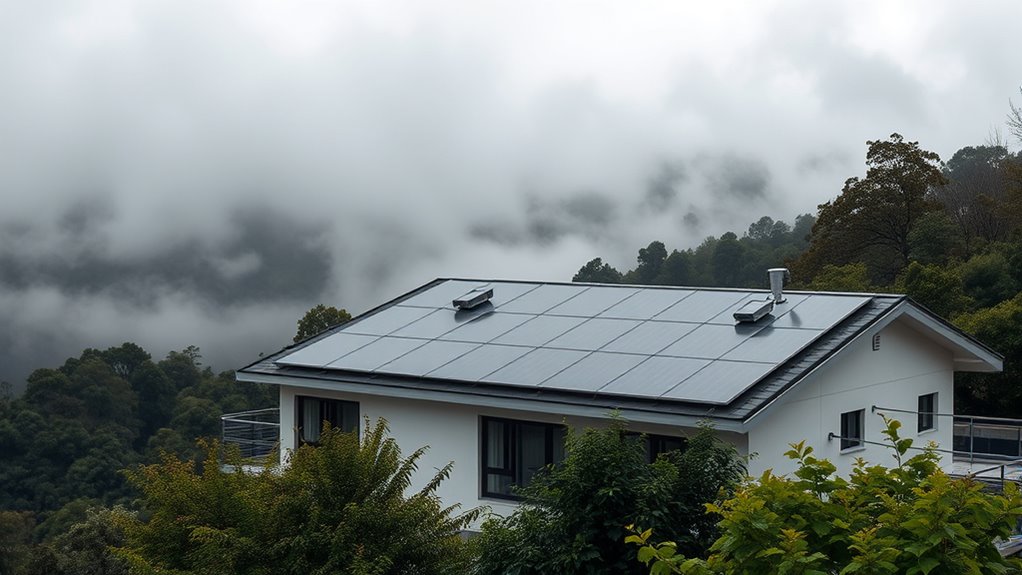
To effectively adapt solar-powered heat pump systems for cloudy climates, you need to incorporate design strategies that maximize heat capture and minimize energy loss. Use thermal mass, like concrete or brick, to absorb heat during sunny periods for later use. Guarantee your building has good insulation and a well-designed envelope to reduce heat loss during cloudy days. Optimize window orientation for maximum solar gain and add shading devices to prevent overheating. Incorporate passive solar elements, such as south-facing glass and overhangs, to control solar input. Consider hybrid systems that combine solar with other heating methods, like heat pumps, for consistent performance. Smart controls and energy storage also help balance energy supply and demand, making your system more resilient in low-light conditions. Additionally, understanding the best anime movies can inspire innovative design concepts and motivate creative problem-solving during project planning.
Performance Metrics From Field Studies
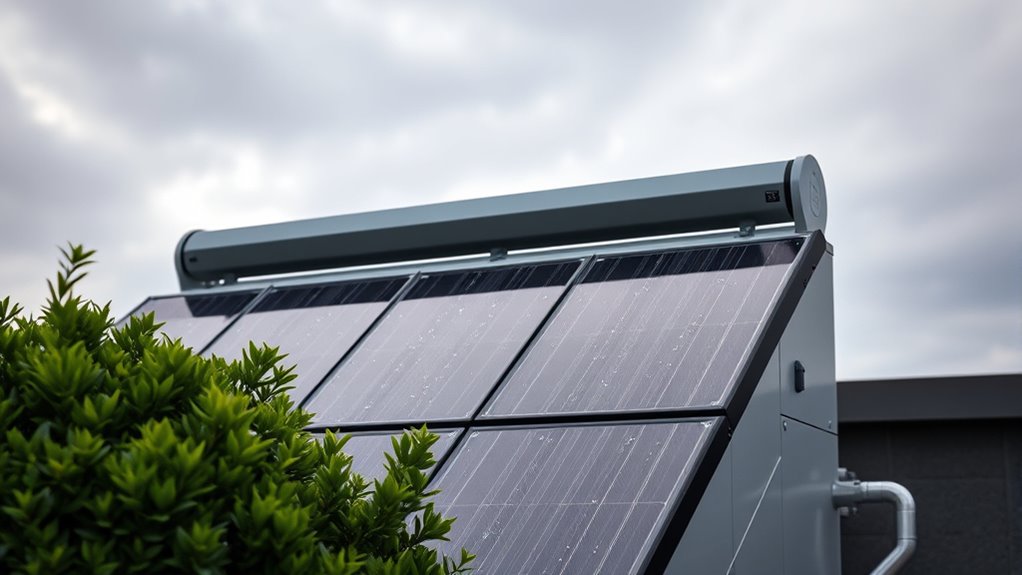
Have you ever wondered how solar-powered heat pumps perform outside the lab? Field studies show that real-world performance often falls short of laboratory ratings, with seasonal COPs typically between 2.0 and 2.5. These metrics reveal how outdoor temperatures, humidity, and climate impact efficiency. In colder or more humid conditions, performance can decline due to environmental stressors. Installation quality and system design also play vital roles, with well-designed systems achieving better efficiency. Solar integration effectiveness is measured by metrics like PR and SCR, which indicate how well solar input supports operation. Despite the challenges, properly integrated systems can still deliver high energy efficiency, though actual energy consumption often exceeds initial predictions due to climatic and operational variability. External factors such as weather conditions also significantly influence the system’s overall performance and reliability.
Benefits of Hybrid Solar and Heat Pump Systems
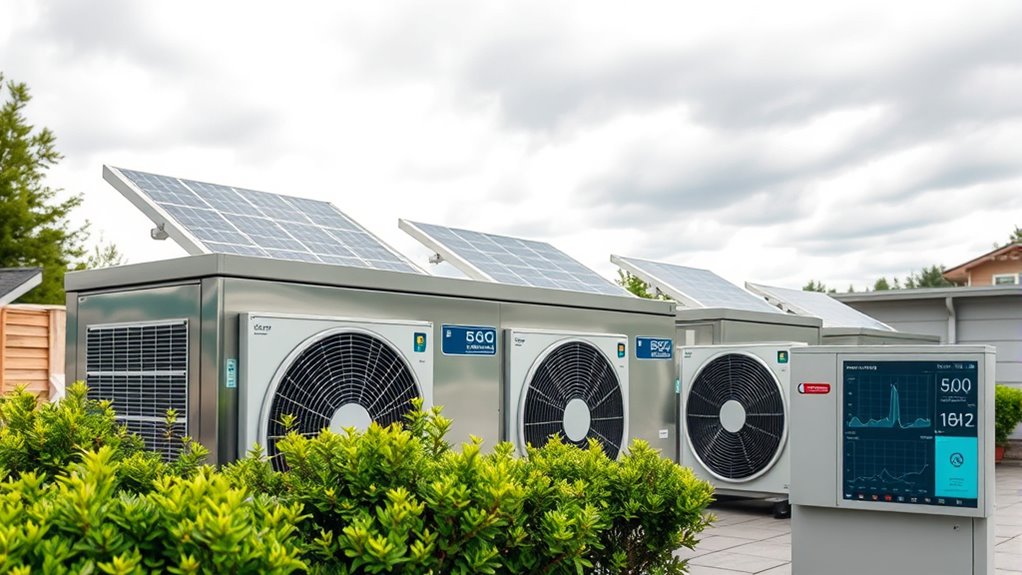
Hybrid solar and heat pump systems boost your energy efficiency by combining two powerful technologies, saving you money on energy bills. They deliver reliable performance throughout the year, even in cloudy climates, by switching seamlessly between energy sources. Plus, integrating solar with heat pumps is a cost-effective way to maximize renewable energy use and reduce your carbon footprint. Hybrid heat pumps can operate efficiently without minimum insulation levels, making them suitable for a wide range of building types. Additionally, the contrast ratio of the system’s components can influence overall performance and efficiency in varying conditions.
Enhanced Energy Efficiency
By combining solar power with heat pump technology, these systems considerably boost energy efficiency and reduce reliance on nonrenewable resources. They achieve higher efficiencies through optimized control strategies and solar input, often exceeding traditional heat pump COPs of about 2.65. Daily energy outputs can reach nearly 0.86 kWh of electricity and 6.35 kWh of thermal energy, cutting nonrenewable energy use by up to 86%. Technological improvements, like better compressors and refrigerants, have raised ratings such as SEER2 and HSPF2, enabling more heat output per unit of electricity. This synergy results in significant energy savings and lower emissions, especially valuable in cloudy climates where solar contribution still offsets grid power. Hybrid systems demonstrate improved performance in diverse weather conditions, leading to higher COPs, even in cold weather, and increased seasonal performance ratings. Incorporating refrigeration cycle efficiency enhancements and smart controls further optimizes system performance, resulting in greater energy savings compared to standalone systems. Greater energy savings further reduce fossil fuel dependence.
Reliable Performance Year-round
Combining solar power with heat pump technology creates systems that perform reliably throughout the year, even in variable weather conditions. These hybrid systems adapt to changing climates by using solar energy when available and switching to heat pump efficiency during low sunlight periods. They maintain consistent heating and cooling, ensuring energy resilience in cloudy or less sunny days. Flexibility in design allows optimization based on your local climate and energy needs. Here’s a quick overview:
| Climate Adaptability | Year-Round Consistency | Energy Resilience |
|---|---|---|
| Leverages solar and heat pump efficiencies | Maintains performance despite weather changes | Stores excess energy for backup |
| Adapts to variable weather | Uses solar in sunny periods, heat pumps otherwise | Ensures reliable energy supply |
| Optimized for local conditions | Supports continuous operation | Reduces dependence on grid |
Cost-Effective Integration
Integrating solar power with heat pump technology offers a cost-effective way to lower your long-term energy expenses. By combining these systems, you can appreciably reduce your reliance on the grid and cut operational costs. Hybrid systems capitalize on solar energy, especially during sunny periods, decreasing energy overhead and maximizing efficiency. Plus, they often qualify for government incentives and rebates, boosting your savings. The initial investment may be higher, but the long-term savings on energy bills outweigh this cost. As technology improves, these systems become even more efficient and reliable. They’re adaptable to various climates and easy to install, making them a practical choice for many households seeking to lower energy costs while supporting sustainability. Understanding hybrid solar and heat pump systems can help you make informed decisions about their implementation.
Case Study: Purdue’s Cloudy Weather Experiment
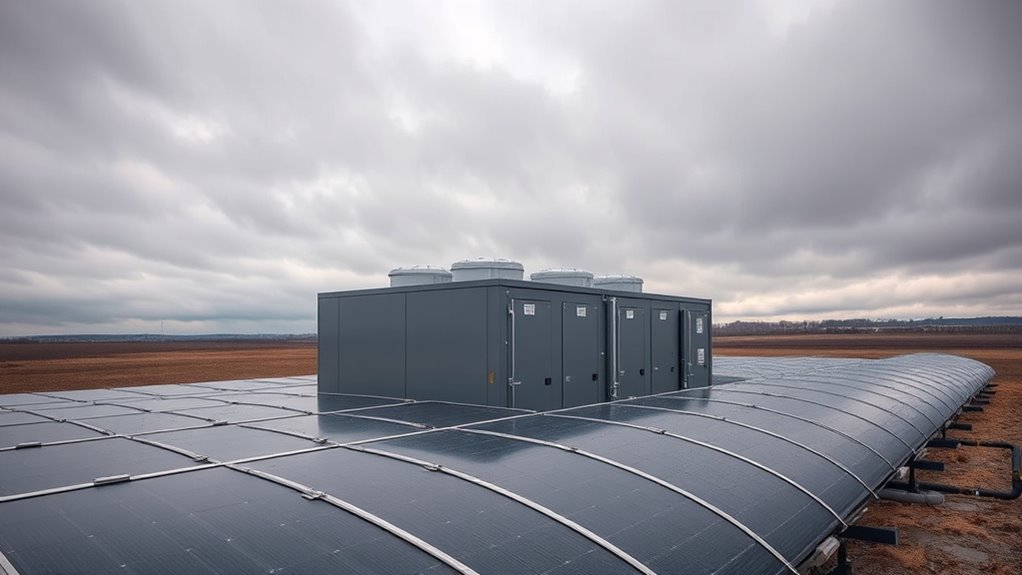
In Purdue’s experiment, you’ll see how weather impacts system efficiency, especially during cloudy days. The researchers used detailed data collection to measure performance across different conditions, revealing notable variability. These insights help you understand how weather influences the effectiveness of solar-powered heat pumps. Advancements in predictive control systems enable the system to adapt to changing weather patterns, optimizing performance even when sunlight is limited. Additionally, incorporating weather variability into system models enhances their ability to predict performance under diverse conditions.
Weather Impact on Efficiency
Weather conditions, especially cloud cover, have a significant impact on the efficiency of solar-powered heat pumps. When clouds block sunlight, solar intensity drops, reducing energy generation and system performance. Different cloud types influence how much solar energy reaches the panels, with sunny days yielding much higher efficiency than cloudy ones. For example, the energy factor (EF) on sunny days averages 35.68, but plummets to just 2.77 during cloudy weather. This strong correlation between solar intensity and EF highlights the importance of weather in system design. To address this, backup power sources and energy storage become essential. Understanding these weather-driven variations helps you optimize performance and develop more resilient systems for cloudy climates.
- Effect of cloud types on solar EF
- Variations in solar intensity and EF
- Importance of backup power
- Role of energy storage in performance
Data Collection Methodology
To accurately assess the performance of solar-powered heat pumps under cloudy conditions, Purdue’s experiment deploys a thorough sensor network and controlled environment setup. Temperature sensors, specifically T-type thermocouples, are placed at critical water and air junctions to monitor thermal variations. Power consumption is tracked using dedicated transducers, while voltage and current from solar panels are measured with voltage dividers and shunts, respectively. A flow meter in the circulation loop captures water movement data. Sensors are precisely located at system inlets and outlets, including ground water, circulating water, air intake/outlet, and solar input. The laboratory setup replicates real-world conditions, with environmental chambers simulating cloudy weather. Automated data loggers record all sensor outputs continuously, enabling detailed analysis of system performance under controlled, repeatable conditions. Data accuracy is enhanced by calibrating sensors regularly to ensure reliable measurements.
Performance Variability Insights
Purdue’s cloud weather experiment reveals notable insights into the variability of solar-powered heat pump performance under different sky conditions. You’ll notice that the Solar Energy Factor (EF) drops sharply on cloudy days, averaging just 2.77 compared to 35.68 on sunny days. Meanwhile, the heat pump’s efficiency remains relatively stable across weather variations, hovering around 1.25. The overall system performance strongly correlates with solar intensity, highlighting how cloud cover reduces solar contribution and impacts energy output. You’ll see that partly cloudy days offer intermediate performance, while system design, including hybrid features and advanced controls, helps stabilize operation during unpredictable weather. These findings emphasize the importance of adaptive strategies for reliable energy savings in cloudy climates. Additionally, tuning of system components can optimize performance and resilience in variable weather conditions.
Optimizing Operations in Variable Weather Conditions
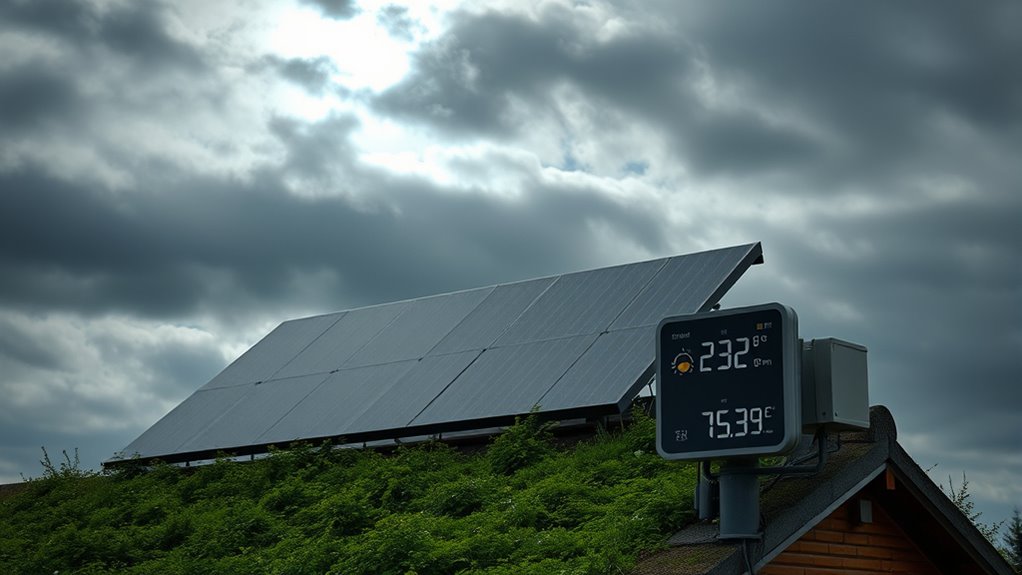
Variable weather conditions pose a challenge for solar-powered heat pumps, but you can optimize their performance by implementing strategic measures. Use battery storage to buffer fluctuating output and maintain continuous operation. Installing advanced solar technologies like bifacial panels helps capture diffused and reflected sunlight during cloudy days. Adjust your energy use and setpoints during prolonged overcast periods to conserve stored power. Monitor weather forecasts to anticipate low-sun periods and plan accordingly. Consider hybrid systems that can switch to grid power when solar energy drops markedly. Also, optimize panel angles and keep them clean to maximize light absorption. Solar panels can generate electricity despite reduced sunlight levels, and combining these strategies, you can improve efficiency, ensure consistent operation, and make the most of available solar energy, even in unpredictable weather conditions. Additionally, employing solar energy management systems can help optimize energy flow and storage, further enhancing system performance during variable weather.
Frequently Asked Questions
How Do Seasonal Changes Affect Solar-Powered Heat Pump Efficiency?
Seasonal changes impact your solar-powered heat pump efficiency by altering sunlight availability and temperature. In summer, longer days and more direct sunlight boost energy input, but high temperatures can slightly reduce panel efficiency. During winter, shorter days and lower sun angles decrease energy production, though cooler temperatures may help panels operate better. To maximize performance year-round, optimize panel angles, consider tracking systems, and incorporate energy storage to handle seasonal variations.
What Are the Long-Term Maintenance Requirements for Hybrid Solar Systems?
Think of your hybrid solar system as a finely tuned orchestra that needs regular tuning to perform at its best. You should inspect panels annually for dirt and debris, clean gently, and check connections for corrosion. Monitor batteries and inverters, making sure they stay cool and responsive. Schedule professional checks for thermal components, and review system data regularly. Keeping these routines guarantees your system remains a harmonious, efficient performer for years to come.
How Cost-Effective Are Solar-Powered Heat Pumps in Predominantly Cloudy Regions?
You’ll find that solar-powered heat pumps can be quite cost-effective in cloudy regions. Even when sunlight is limited, hybrid systems combine solar energy with grid power, reducing your energy bills by up to 80%. The initial investment might be higher, but long-term savings, incentives, and lower maintenance costs improve overall value. Plus, advances in technology and energy storage help maintain efficiency, making these systems a smart choice for cloudy climates.
Can Existing HVAC Infrastructure Be Retrofitted for Solar Integration Effectively?
You can retrofit your existing HVAC infrastructure for solar integration, but it requires careful planning. You’ll need to modify piping, potentially upgrade emitters for lower water temperatures, and add zone valves for efficiency. Compatibility between your current system and solar components is vital. Investing in system balancing and energy storage can improve performance. While it’s doable, expect some costs and technical adjustments to guarantee seamless integration and peak operation.
What Are the Environmental Benefits of Deploying Solar Heat Pumps in Cloudy Climates?
You can enjoy significant environmental benefits by deploying solar heat pumps in cloudy climates. These systems cut greenhouse gas emissions by up to 75%, reducing reliance on fossil fuels and lowering air pollution. They also use renewable energy, even when it’s cloudy, supporting sustainability. By minimizing energy consumption and leveraging technological adaptations like hybrid systems, you contribute to a cleaner environment while saving on energy costs.
Conclusion
Think of solar-powered heat pumps in cloudy climates like a sunflower turning toward the sun—it finds ways to thrive even on cloudy days. Field data shows these systems can deliver reliable heating, with performance maintained through smart design and hybrid approaches. Just as a seasoned sailor adjusts sails to navigate changing winds, you can optimize operations to harness energy efficiently, ensuring your system stays resilient regardless of the weather. Embrace the challenge, and let the sun’s hidden rays power your comfort.
I’m Theodore, and I love tiny houses. In fact, I’m the author of Tiny House 43, a book about tiny houses that are also tree houses. I think they’re magical places where imaginations can run wild and adventures are just waiting to happen.
While tree houses are often associated with childhood, they can be the perfect adult retreat. They offer a cozy space to relax and unwind, surrounded by nature. And since they’re typically built on stilts or raised platforms, they offer stunning views that traditional homes simply can’t match.
If you’re looking for a unique and romantic getaway, a tree house tiny house might just be the perfect option.
